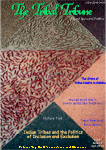Tribal Poverty in Rural Odisha
| Abstract | Methodology |
| Introduction | Result and Analysis |
| Source of Data | Conclusion |
Abstract
This study is based on the combined result of NSS state sample and central sample conducted by two separate agencies of State and Central Government respectively. It has analyzed the tribal poverty in rural Odisha by making five economic classes on basis of monthly per capita consumer expenditure of the rural households. It has also computed the projected households and projected population for tribal categories using combined NSS result of the year 2009-10 in provisional population of Census 2011.
Introduction
Odisha is one of the states having highest tribal population in the country. The regional terminologies like Adivasi (original settlers), Girijan (hill dwellers), Vanya jati (forest caste men), Adimjati (Primitive castes), and Anusuchit Janjati (Scheduled tribes) are used to designate the tribal population. The tribal communities are found in almost all the 30 districts of Orissa and half of their total population is concentrated in Koraput, Rayagada, Nawarangpur, Malkangiri, Sundargarh, Mayurbhanj,Gajapati, Kalahandi, Keonjhor, Nuapara, Kandhamal and Ganjam. They are the most vulnerable section of our society living in natural and unpolluted surrounding with their traditional values, customs and beliefs. Though their life is affected by chronic poverty, no specific poverty statistics is presently available for tribal people of Odisha. The Planning Commission (2011, 2012) has currently, using the latest methodology due to Tendulkar, estimated national as well as state specific poverty lines for both rural and urban sector separately The present study is an attempt to determine the latest picture of tribal poverty for rural Odisha on the base of the latest available data (2009-10) of National Sample Survey (NSS) as well as of census (provisional) 2011.
Source of Data
The study has used two equal and independent sets of sample data of National Sample Survey collected during the year 2009-10 under the head ‘Household Consumer Expenditure’ by two separate Government Organisations viz., NSSO (National Sample Survey Office), Govt of India and Directorate of Economics and Statistics, Govt of Odisha. It is material to mention that the procedure provided in the NSSO publication ‘Notes on Sample Design and Estimation procedure for 66th round NSS (for the year 2009-10)’ is relied upon to derive the estimated figures for the year 2009-10 from the combined NSS raw data. For the analysis of tribal poverty, the latest poverty line of rural Odisha (2009-10) declared by Planning Commission (2012) has been used. To compute the projected figures for the year 2011, the provisional rural population of Census 2011 has been used.
Methodology
Using a well-known procedure of pooling (Minhas and Sardana, 1990) of two independent samples, two data sets have been pooled to double the sample size. Though the normal sample size is adequate only for state level estimate, for efficient poverty analysis of tribal groups sample size has been increased. Planning Commission of India has officially declared for rural Odisha , the latest (for the year 2009-10) poverty line as Rs 567.10 i.e any household in rural Odisha with monthly per capita consumer expenditure less than Rs 567.10 is considered as a poor household. This poverty line is used with the combined NSS data for the poverty analysis here. In this study it has been attempted to reach the poorest class of tribal people by making five classes (pentile classes) based on monthly per capita consumer expenditure of tribal households of rural Odisha. To reach such class, which are found in the backward region of Odisha, this region is identified as consisting of the districts of Koraput, Rayagada, Nabarangpur, Malkanagiri, Kalahandi, Nuapada, Bolangir, Sonepur, Gajapati, Kandhamal and Boudh. Again the result of combined NSS data of the year 2009-10 has been projected for the year 2011 using the provisional rural population data of census 2011.
Result and Analysis
A.Tribal population of rural Odisha.
Table A1: Category wise population and households of Rural Odisha
|
Category |
Population* |
Households* |
|
Tribal |
8308036 |
2035300 |
|
SC |
7405873 |
1661217 |
|
Others |
19237326 |
4242919 |
|
Total |
34951234 |
7939435 |
Table A2: Category wise population and household distribution of Rural Odisha
|
Category |
% share of population |
% share of households |
|
Tribal |
24 |
26 |
|
SC |
21 |
21 |
|
others |
55 |
53 |
|
Total |
100 |
100 |
Table A3: Region and category wise population of Rural Odisha
|
Population |
Backward Region |
Other Region |
All |
|
Tribal* |
3879260 |
4386679 |
8265938 |
|
SC* |
2285762 |
5112254 |
7398016 |
|
others* |
3157489 |
16129790 |
19287280 |
|
Total |
9322511 |
25628723 |
34951234 |
Table A4: Region and category wise population distribution of Rural Odisha
|
Population |
Backward Region |
Other Region |
All |
|
Tribal |
47 |
53 |
100 |
|
SC |
31 |
69 |
100 |
|
others |
16 |
84 |
100 |
|
Total |
27 |
73 |
100 |
* Census 2011 population and households projected by combined NSS result of 2009-10.
Analysis 1:
The tables A1 and A2 present that during 2011 the tribal population is 8308036 in rural Odisha, which is 24% of the total rural population. The tables A3 and A4 present regional population in different categories. It is observed that47% of tribal people are living in the backward region consists of eleven backward districts where as 53% of tribal people are living in the other region consists of rest nineteen districts. As other region includes some tribal concentrated districts like Sundargarh, Mayurbhanj, Keonjhar and Ganjam the share of tribal for this region is high at 53%. But when the regional shares among different categories are considered, the tribal share is maximum i.e. 47% in the backward region, where only 27% of total rural population are living.
B.Tribal poverty of rural Odisha
Table B1: Category wise poverty percentages of Rural Odisha
|
Category |
Share in poverty (%) |
|
Tribal |
39 |
|
SC |
25 |
|
others |
36 |
|
Total |
100 |
Fig-1
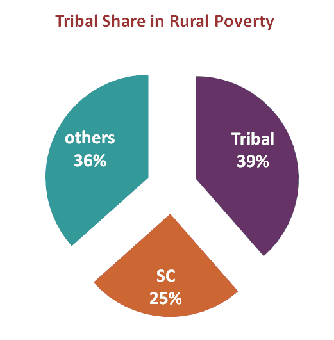
Fig2
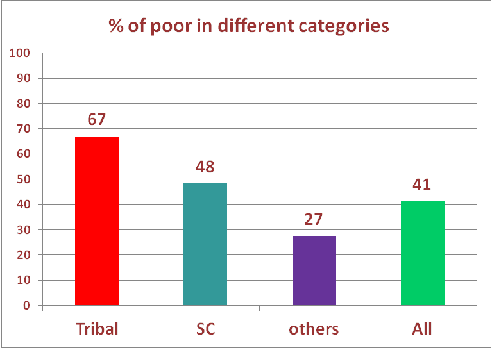
Table B2 : Class wise Category wise population of Rural Odisha
|
Classes |
% Share of the Categories in Five Economic Classes |
||
|
Tribal |
SC |
Others |
|
|
p1 |
50 |
23 |
27 |
|
p2 |
24 |
28 |
48 |
|
p3 |
18 |
25 |
57 |
|
p4 |
16 |
16 |
69 |
|
p5 |
6 |
13 |
81 |
|
Total |
24 |
21 |
55 |
Fig-3

Analysis 2:
Although 24% of total rural population belongs to tribal category, 39% of poor people are tribal (Table B1). That is, in the rural poverty, the share of tribal is the highest. Amongst the tribals of rural Odisha, the poverty percentage is highly significant (67%) compared to the poverty percentage in other categories (Fig-2). In table B2 the entire population according to their monthly per capita consumer expenditure (MPCE) is divided into five economic classes p1, p2…p5, known as pentile classes of standard of living, the lowest class p1 being the poorest class. It is easy to find that among the poorest people of rural Odisha 50% are tribal (Fig-3). The share of tribal is in decreasing order from bottom class to top class.The table B3 placed below shows the average MPCE of tribal people by five economic classes in two different regions.
Table B3: Class wise, Region wise, Average MPCE of Tribal Population
|
Classes |
MPCE in Rs (0.00) of Tribal |
||
|
Backward Region |
Other region |
All |
|
|
p1 |
352.67 |
375.21 |
362.45 |
|
p2 |
520.44 |
519.8 |
519.99 |
|
p3 |
634.97 |
636.42 |
636.12 |
|
p4 |
786.52 |
787.88 |
787.70 |
|
p5 |
1192.82 |
1239.65 |
1235.32 |
|
Total |
445.67 |
602.08 |
559.59 |
C. Household type of tribal people of rural Odisha:
Based on major sources of living for the households, there are three household types viz., Labourers, Cultivators and Others ( include all self employed persons in non agriculture, regular wage salary earners, pensioners, beggars and the ones without any economic activities). The following tables and graphs represent the distribution of household types of tribal people in five economic classes.
Table C1
|
Class |
Cultivators |
Labourers |
Others |
|
p1 |
33 |
54 |
13 |
|
p2 |
46 |
43 |
12 |
|
p3 |
40 |
36 |
24 |
|
p4 |
40 |
38 |
21 |
|
p5 |
30 |
12 |
58 |
|
All |
38 |
45 |
17 |
Fig-C1
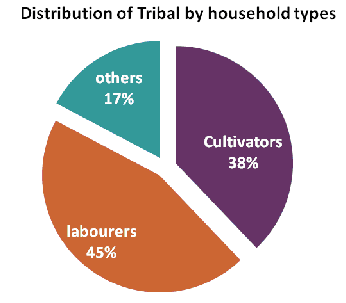
Fig -C2
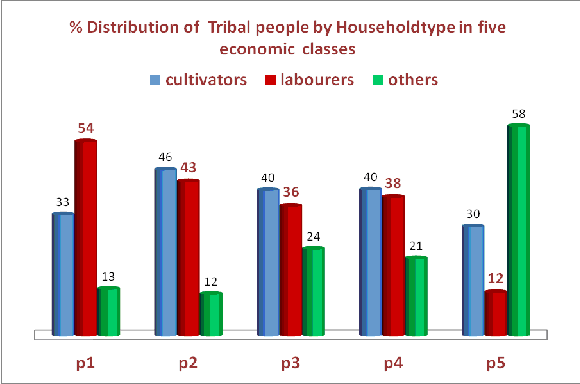
Analysis 3:
From fig C1 it is observed that majority of tribal of rural Odisha that is 45% of household types belong to labourer households. Here labourers include both agriculture and non-agriculture labourers. When the household types are distributed among five economic classes it is also observed that majority of tribal people in first four economic classes belong to household types of labourers and cultivators. As per the guideline of National Sample Survey, any person cultivating his own land or possessed land is called as cultivator. The poorest tribal class p1 has maximum 54% households of laborer type. The top class p5 contains highest 58% households of other types which include the affluent categories like self-employed in non-agriculture and regular wage salary earners.
Conclusion
The study has investigated a number of issues relating to tribal poverty of the rural Odisha based on latest available NSS result of 2009-10 and census 2011.It is observed that while 24% of total rural population of Odisha belongs to the tribal category of population, 39% of total rural poor are tribal. Nearly half of the tribal people (i.e. 47%) are living in the backward region consisting of eleven backward districts (8 districts of undivided KBK, Gajapati, Boudh and Kandhamal) where as only 27% of total rural population are living in this backward region. In spite of massive planning and bulky expenditure of both the state and central governments for tribal people, 67% among them are poor. Further what attracts ones notice most are the figures that among the poorest people of rural Odisha 50% are tribal and amongst the poorest tribal households, 54% of the households are of laborer type. The top tribal class contains majority households of other types, which include the affluent categories like self employed in non agriculture and regular wage salary earners. Hence it can be concluded that the special facilities provided to the tribal people are not reaching the bottom. The provisions envisaged by the governments for the uplift of tribals needs to be so implemented that the poorest among tribals get the benefit. It is not in the interest of the wholesome improvement of the lot of tribal communities, if the benefits of tribal planning flow to affluent tribals to the exclusion of their poorest brethren. There should be some saturation in facilities for upper class tribal people. More scopes and facilities should be provided to poorest class of tribal. Needless to say, it poses challenge to the planners and policy makers as to how their planning and policies for tribal development can be effectively implemented so that the poorest among the tribals are benefited most.
References
- Minhas, B.S., & Sardana, M.G. (1990). A note on pooling of central and state Sample data of NSS. Sarvekshana, Issue 44, Vol.XIV, No.1, 1-4.
- Planning Commission. (2011). Report of export group to review the methodology for estimation of poverty under the chairman ship of prof S. Tendulkar, Government of India: Author
- Planning Commission. (2012). Press note on poverty estimates, 2009-10, Government of India: Author


